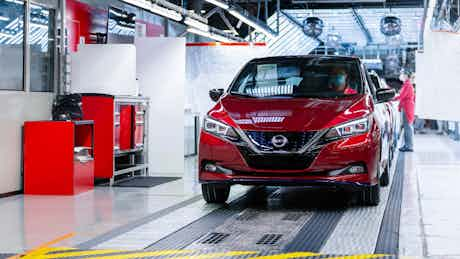Car changing is a big deal
Analysis of 50 million MoT tests shows electrified vehicles doing better than petrol and diesel counterparts, though EVs and hybrids are more likely to have defective tyres
Hybrid and electric vehicles are more likely to pass their MoT tests at the first attempt than their petrol and diesel counterparts, carwow can reveal.
The statistics, obtained from the Driver and Vehicle Standards Agency (DVSA) via freedom of information request, cover 49.9 million MoT tests carried out on vehicles aged between three to nine years, over 2019, 2020 and 2021, and show that just 14.84% of hybrid cars and 17.87% of pure electric cars failed their MoT at the first attempt between 2019 and 2021.
The average failure rates for petrol vehicles over those three years was 20.07%, while diesels brought up the field, with an average first-time failure rate of 23.11%.
| Fuel type | Number of tests, 2019-21 | Number of failures | Average MoT failure rate* |
| Hybrid | 1,115,701 | 165,611 | 14.84% |
| Electric | 155,033 | 27,701 | 17.87% |
| Petrol | 23,496,677 | 4,714,792 | 20.07% |
| Diesel | 25,141,752 | 5,809,650 | 23.11% |
*Failure rates for Class 3 and 4 vehicles aged three to nine years old.
There are a number of possible reasons for EVs being more likely to pass their MoT test first time, including the fact that they are subject to fewer checks as part of the MoT. Petrol and diesel vehicles can fail for producing excess levels of harmful emissions from their exhaust, for example, but EVs don’t produce any emissions on the road at all.

Petrol and diesel vehicles are also subject to checks on their fuel lines, catalytic converters and diesel particulate filters; because EVs have none of these items, there are simply fewer opportunities for them to fail the test. One possible reason for the higher rate of failure among diesels, meanwhile, is that Class 4 vehicles include small vans, which often live hard lives.
Addressing the impressive failure rate for hybrid cars is less clear-cut, though hybrids are far less likely to fail the MoT test for “noise, emissions and leaks”. Just 1.29% hybrids that didn’t pass their MoT test had a failure in this category, compared to 6.46% for diesel vehicles, and 5.42% for petrols.
Testing times for tyres
But while electric and hybrid vehicles are more likely to pass their MoT first time, they are more likely to fail for having tyres that don’t meet legal minimum requirements.
Cars can fail an MoT for more than one reason, but over a third (36.18%) of EVs that failed their MoT had tyres that didn’t meet legal standards. Hybrids didn’t fare much better, with 33.24% of all failing hybrids having substandard tyres. With diesel vehicles the tyre failure rate was 28.18%, while just 25.94% of failing petrol vehicles had defective tyres.
One potential reason for the relatively high tyre failure rate for electric vehicles is the instant torque such vehicles can deploy, which puts strong forces through tyres. Similarly, electric vehicles tend to be significantly heavier than petrol and diesel ones due to the weight of their battery packs, with this extra mass also likely to cause tyre wear.

| Fuel type | Percentage of failing cars with defective tyres, 2019-2021 |
| Electric | 36.18% |
| Hybrid | 33.24% |
| Diesel | 28.18% |
| Petrol | 25.94% |
New MoT rules were introduced in 2018, so for consistency our analysis concerns tests from 2019, 2020 and 2021, while we also put a nine-year age limit on the vehicles whose data we analysed to give more of a level playing field, as very few electric vehicles are older than this.
While the number of petrol and diesel vehicles significantly outweighs the number of hybrids and EVs, this data paints a nationwide picture of how likely it is a vehicle will pass its MoT based on what powers it.
Vehicles are consistently less likely to pass the MoT test as they age, with the worst pass rate in the data being for nine-year-old diesel vehicles, of which just 65.81% passed their MoT at the first attempt. Three-year-old hybrids had the best pass rate, with 88.86% sailing through the test, while three-year-old petrol vehicles were actually slightly more likely to pass their MoT first-time than three-year-old EVs.
| Failure rate at three years old | Failure rate at nine years old | |
| Hybrid | 11.14% | 24.16% |
| EV | 12.18% | 25.54% |
| Petrol | 11.17% | 31.71% |
| Diesel | 15.32% | 34.19% |
Commenting on the data, the DVSA’s head of MoT policy, Chris Price, told carwow:
“We know that overall the MoT failure rate for hybrid and electric vehicles is lower than that for conventionally powered vehicles. However, it is important to understand the detail behind that – as some test items, such as tyres, have comparatively higher fail rates in EVs.
“There will be many reasons for differing overall rates, including the relative newness of these vehicles, fewer things to fail (such as emissions), how the vehicles are serviced and fewer mechanical parts.”
Price added: “The best way to ensure your vehicle, however it’s powered, passes the MoT is to ensure it is properly maintained and that you carry out basic safety checks.”
If you’re looking at changing cars, you can check the MOT history of a vehicle for free.
